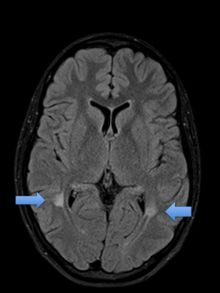
Multiple sclerosis (MS) is a chronic inflammatory disease of the central nervous system (brain and spinal cord). It is caused by an autoimmune process against components of the nerve sheath, against myelin. The myelin sheaths ‘isolate’ the nerve fibres (axons) and ensure that nerve impulses are rapidly transmitted. So-called ‘plaques’ form in the central nervous system as a result of this immune process.
Magnetic resonance imaging is the most accurate method to detect the typical plaques in the brain and spinal cord. It is used to diagnose and monitor the progression of MS for exactly this reason. Certain findings in the cerebrospinal fluid also play a role in diagnosis (so-called oligoclonal bands in the cerebrospinal fluid).
In addition to multiple sclerosis, there are several other inflammatory diseases of the central nervous system, for which diagnostic magnetic resonance imaging is the best imaging technique. These include bacterial infections such as abscesses or borreliosis in addition to viral diseases such as herpes or cytomegalo virus encephalitis.
Magnetic resonance imaging is the method of choice for taking images of the brain and spinal cord due to the superior display capabilities compared to other imaging methods (such as computerised tomography).
The image shows inflammatory plaques on the edge of the brain ventricle (arrow).


